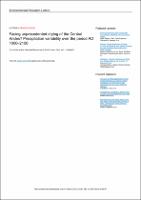Mostrar el registro sencillo del ítem
Facing unprecedented drying of the Central Andes? Precipitation variability over the period AD 1000-2100
| dc.contributor.author | Neukom, R. | |
| dc.contributor.author | Rohrer, M. | |
| dc.contributor.author | Calanca, P. | |
| dc.contributor.author | Salzmann, N. | |
| dc.contributor.author | Huggel, C. | |
| dc.contributor.author | Acuña, Delia | |
| dc.contributor.author | Christie, D.A. | |
| dc.contributor.author | Morales, M.S. | |
| dc.date.accessioned | 2019-07-27T23:48:07Z | |
| dc.date.available | 2019-07-27T23:48:07Z | |
| dc.date.issued | 2015-08 | |
| dc.identifier.uri | http://repositorio.senamhi.gob.pe/handle/20.500.12542/95 | |
| dc.description.abstract | Projected future trends in water availability are associated with large uncertainties in many regions of the globe. In mountain areas with complex topography, climate models have often limited capabilities to adequately simulate the precipitation variability on small spatial scales. Also, their validation is hampered by typically very low station density. In the Central Andes of South America, a semi-arid high-mountain region with strong seasonality, zonal wind in the upper troposphere is a good proxy for interannual precipitation variability. Here, we combine instrumental measurements, reanalysis and paleoclimate data, and a 57-member ensemble of CMIP5 model simulations to assess changes in Central Andes precipitation over the period AD 1000-2100. This new database allows us to put future projections of precipitation into a previously missing multi-centennial and pre-industrial context. Our results confirm the relationship between regional summer precipitation and 200 hPa zonal wind in the Central Andes, with stronger Westerly winds leading to decreased precipitation. The period of instrumental coverage (1965-2010) is slightly dryer compared to pre-industrial times as represented by control simulations, simulations from the past Millennium, ice core data from Quelccaya ice cap and a tree-ring based precipitation reconstruction. The model ensemble identifies a clear reduction in precipitation already in the early 21st century: the 10 year running mean model uncertainty range (ensemble 16-84% spread) is continuously above the pre-industrial mean after AD 2023 (AD 2028) until the end of the 21st century in the RCP2.6 (RCP8.5) emission scenario. Average precipitation over AD 2071-2100 is outside the range of natural pre-industrial variability in 47 of the 57 model simulations for both emission scenarios. The ensemble median fraction of dry years (defined by the 5th percentile in pre-industrial conditions) is projected to increase by a factor of 4 until 2071-2100 in the RCP8.5 scenario. Even under the strong reduction of greenhouse gas emissions projected by the RCP2.6 scenario, the Central Andes will experience a reduction in precipitation outside pre-industrial natural variability. This is of concern for the Central Andes, because society and economy are highly vulnerable to changes in the hydrological cycle and already have to face decreases in fresh water availability caused by glacier retreat. | en_US |
| dc.format | application/pdf | |
| dc.language.iso | eng | en_US |
| dc.publisher | Institute of Physics Publishing | en_US |
| dc.relation.ispartof | urn:issn:1748-9318 | |
| dc.rights | info:eu-repo/semantics/openAccess | |
| dc.rights | Attribution-NonCommercial-ShareAlike 3.0 United States | * |
| dc.rights.uri | http://creativecommons.org/licenses/by-nc-sa/3.0/us/ | * |
| dc.source | Servicio Nacional de Meteorología e Hidrología del Perú | es_PE |
| dc.source | Repositorio Institucional - SENAMHI | es_PE |
| dc.subject | Andes | |
| dc.subject | Cambio Climático | |
| dc.subject | Climate projections | en_US |
| dc.subject | Paleoclimate | en_US |
| dc.subject | Precipitación | |
| dc.subject | South America | en_US |
| dc.title | Facing unprecedented drying of the Central Andes? Precipitation variability over the period AD 1000-2100 | en_US |
| dc.type | info:eu-repo/semantics/article | en_US |
| dc.identifier.isni | 0000 0001 0746 0446 | |
| dc.description.peerreview | Por pares | |
| dc.identifier.doi | https://doi.org/10.1088/1748-9326/10/8/084017 | |
| dc.source.volume | 10 | en_US |
| dc.source.issue | 8 | en_US |
| dc.source.journal | Environmental Research Letters | en_US |
| dc.subject.ocde | https://purl.org/pe-repo/ocde/ford#1.05.10 | |
| dc.subject.sinia | precipitacion - Clima y Eventos Naturales | |
| dc.type.sinia | text/publicacion cientifica | |
| dc.identifier.url | http://repositorio.senamhi.gob.pe/handle/20.500.12542/95 |
Ficheros en el ítem
Este ítem aparece en la(s) siguiente(s) colección(es)
-
Artículo científico [171]









